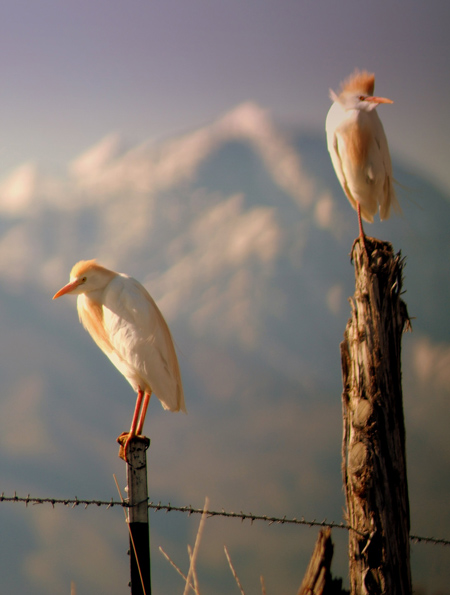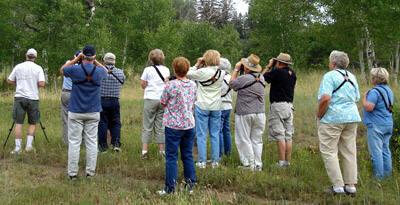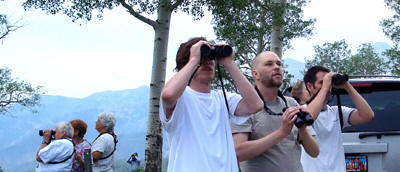Utah County Birders Newsletter
|
 |
|
photo by Ryan Houston |
Cattle Egret
Bubulcus ibis
by Tom Williams
In his book Wild America, Roger Tory Peterson notes that although the Cattle Egret (Bubulcus ibis) had become common in the U.S. by 1954, only a few years earlier he had gone hundreds of miles out of his way to see one on a trip to Africa. The first U.S. record is dated 1941 but by 1953 these small herons, native to Africa and Asia, had begun breeding here. There are now breeding records in almost every state although the birds are most common in the gulf coast states and the southeastern coast states. In Utah, it is a common summer bird.
The Cattle Egret is in one of some 20 genera in the family Ardeidae, which includes bitterns, egrets, and herons. It is the only species in the genus Bubulcus.
Its name is derived from its practice of following cattle (and sometimes horses or tractors) to forage on insects disturbed by their passage. Indeed these birds may sometimes be seen perched on the back of grazing cattle. According to Birds of North America Online in many places
the “common name is Cow Crane, Cow Heron, or Cow Bird or [the bird] is named for the wild grazing animal with which it usually associates – e.g., Elephant Bird, Rhinoceros Egret, or Hippopotamus Egret. . . . Other names involving the word tick, such as Tick Bird refer to the erroneous belief that Cattle Egrets pick attached ticks from grazing animals; most Cattle Egrets’ prey, however, are insects disturbed by the cattle’s grazing.
At 18 to 22 inches tall and with a wingspan of 35 to 38 inches, the Cattle Egret is one of the smaller U.S. herons. The sexes are similar, with all-white plumage most of the year but with buffy coloring on the head, breast and back when the birds achieve full alternate plumage.
These birds are not difficult to identify but they can be confused with the somewhat larger Snowy Egret. The buffy coloration is a good distinguishing mark but cannot always be relied on since it is present only during the relatively brief period of full alternate plumage. Other clues include habitat and the size, shape, and color of unfeathered portions of the bird.
While the Snowy Egret is mostly commonly found in or near water, the Cattle Egret is more likely to be seen in open habitat such as fields or pastures. The Cattle Egret has a sturdy yellow bill which helps distinguish it from the Snowy Egret with its darker, more slender bill. Also, the legs and feet of the Cattle Egret are uniformly dark, while the Snowy Egret has dark legs with bright yellow feet.
Cattle Egrets are known to nest in large colonies with other Ardeidae, sometimes
using abandoned nests. Thus if you find a large colony of waders, it might be
worth your while to scan the entire colony rather than assuming that it is made
up of a single species.
 |
|
Utah County Birders in Payson Canyon -
11 July 2007 |
 |
|
UCB at the Purple Marten Aspens
- 11 July 2007 |
Field Trip Report
Payson Canyon - 11th July 2007
by Tuula Rose
Our monthly meeting took the form of an evening field trip, this time to Payson
Canyon. Eric Huish was our leader .We had a good sized group showing up at the
Payson Park & Drive when the skies to the south turned murky and a strong wind
and dust storm was threatening to cancel the plans. However, the canyon turned
out to be out of the reach of the storm and very pleasant.
The birds were scarce at first until we got up higher to a small wetland place
where several Lincoln sparrows were giving us good looks. Yellow warblers were
singing. Mountain and black-capped chickadees and chipping sparrows were also
seen. Our target birds were the three-toed woodpecker and the purple martin.
Merrill pointed out the tree trunks where the three-toed had been chipping the
bark off in search of grubs. No luck on catching the birds in action though. We
had better luck with the martins and saw three or four flying around with many
tree swallows. One even stopped on top of a dead tree to pose for great looks
through the scopes.
The long drive down the canyon in the dark was a bit nerve wrecking because of
multitudes of deer browsing on the sides of the road, crossing in front of cars.
Participants: Eric Huish, Milton Moody, Matt Mills, Leena Rogers, Tuula Rose,
Carol-Jean Nelson, Bonnie Williams, Yvonne Carter, Robin Tuck, Merrill Webb,
Larry Draper, Bill Slater, Sylvia and Bert Cundick, Leila Ogden and her neighbor
Bobby. Ned Bixler unfortunately had to stay behind after he discovered a flat
tire in the parking lot in Payson.
Field Trip Report
Escalante - 13th & 14th July 2007
by Lu Giddings, fieldtrip leader
A small but enthusiastic group of Utah County Birders traveled to Escalante late
yesterday afternoon. Stops were made at Koosharem Reservoir, at several points
along Highway 12 from Torrey to Boulder to Escalante, and in Boulder. Yesterday
evening's weather was cool and wet as thunderstorms pounded the area both before
we arrived and after sunset. This morning was clear, dry, and began warm and
wound up hot by noon. We birded in Escalante from 7 a.m. until about 12:30 p.m.
After lunch, we decided to make the trek directly home, rather than stop at
Bryce Canyon.
Birds looked for but not seen include:
- vermillion flycatcher
- indigo bunting
- painted bunting
- greater roadrunner
Trip highlights include, in no particular order:
- seeing both an acorn woodpecker and a Lewis's woodpecker at the acorn
woodpecker tree 5.5 miles north of Boulder on Highway 12
- wild turkeys seemingly everywhere in Escalante. Yesterday evening a flock of
13 hens and two toms approached with 10 yards of our vehicles as we sat quietly
at the edge of field, watching them. Once we drove on, another flock of at least
a dozen birds was seen disappearing into the brush along the creek in the field
immediately to the east of the one we had just been watching. And a third large
flock was seen in a field near the sawmill just a few minutes later.
- Wide Hollow Reservoir was alive with black-throated gray warblers this
morning. There seemed to be hundreds of them, in the cottonwoods, in the
willows, in the junipers and sage. At one point I had six of them in one
binocular field of vision at a distance of less than 50'.
- Wide Hollow Reservoir was alive with many other birds as well. An osprey was
seen diving at American coots. There were several hundreds of ducks, mostly in
the shallows at the far ends of the reservoir. Most seem to have begun the molt
into their dreaded, bland standard plumage but a few cinnamon teal were still
sporting breeding plumage, as was a wood duck. One distant beach was occupied by
11 turkey vultures and 7 great blue herons, all within about 50' of each other.
Chipping sparrows were nearly as numerous as black-throated gray warblers.
- young western scrub jays were seen begging from their parents this morning.
And young pinion jays were observed in town, from a very near distance, also
begging from their parents.
Also of note: we received a report of a painted bunting sighting. The young lady
told us it could be seen in the shrubs and trees around her house in Boulder for
several days during the Spring, several years ago. The young lady had not known
what the bird was but her father told her he used to see them all the time when
he grew up in Texas. She described the bird pretty well for a non-birder; I
thumbed through a copy of the National Geographic Field guide with her, looking
at various possibilities, and she was confident that the painted bunting was her
bird. For what it's worth. . . .
84 trip species; 58 species seen in Escalante
Total Count: 84
| Canada Goose Wood Duck Gadwall American Wigeon Mallard Cinnamon Teal Northern Pintail Redhead Ring-necked Duck Lesser Scaup Ruddy Duck Blue Grouse Wild Turkey Pied-billed Grebe Eared Grebe Western Grebe American White Pelican Double-crested Cormorant Great Blue Heron Great Egret Turkey Vulture |
Osprey Red-tailed Hawk Golden Eagle American Kestrel American Coot Killdeer Spotted Sandpiper Long-billed Curlew Californian Gull Eurasian Collared-Dove Mourning Dove Western Scrub-Jay Pinyon Jay Black-billed Magpie Common Raven Tree Swallow Violet-green Swallow Northern Rough-winged Swallow Cliff Swallow Barn Swallow Bewick's Wren |
Blue-gray Gnatcatcher Western Bluebird Mountain Bluebird Townsend's Solitaire American Robin Northern Mockingbird European Starling Yellow Warbler Yellow-rumped Warbler Black-throated Gray Warbler Common Yellowthroat Yellow-breasted Chat Western Tanager Spotted Towhee Chipping Sparrow Lark Sparrow Savannah Sparrow White-crowned Sparrow Dark-eyed Junco Blue Grosbeak Lazuli Bunting |
White-throated Swift Black-chinned Hummingbird Lewis's Woodpecker Acorn Woodpecker Western Wood-Pewee Say's Phoebe Ash-throated Flycatcher Western Kingbird Plumbeous Vireo Steller's Jay Red-winged Blackbird Western Meadowlark Yellow-headed Blackbird Brewer's Blackbird Brown-headed Cowbird Bullock's Oriole Cassin's Finch House Finch Lesser Goldfinch American Goldfinch House Sparrow
|
Backyard Bird of the
Month
July 2007
Steve Carr - Holladay
Bullock's Oriole - Short stop at the watering pan.
Harold Clayson- Salem
Black-headed Grosbeaks - I got a bag of sunflower seeds for Fathers Day
and it's kept them around.
Eric Huish - Pleasant Grove
Western Screech-Owl - Saw a couple owlets while I waited for the
fireworks to start on the 4th.
Milt Moody - Provo
Rufous Hummingbird - as aggressive as ever.
Cheryl Peterson - Provo
Rufous Hummingbirds
Bruce Robinson - West Jordan
Painted Bunting - (OK, so I cheated by a short little 125 miles!!!)
Alton Thygerson - Provo
Rufous Hummingbird - guarding the feeders.
Bonnie Williams - Mapleton
Bullock's Oriole - I've been hearing it but I finally saw it this month.
We would like you to share your favorite backyard bird each
month. Please send your favorite bird at the end of the month to
newsletter@utahbirds.org or call 360-8777. If you would like a reminder at
the end of the month e-mail the above address.